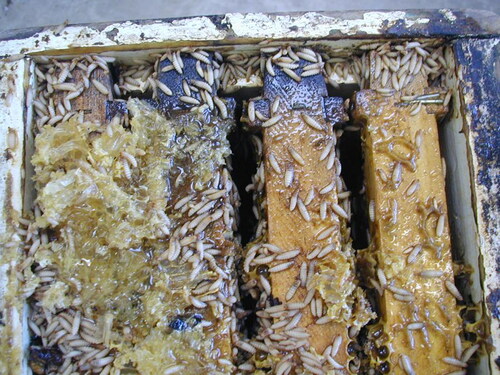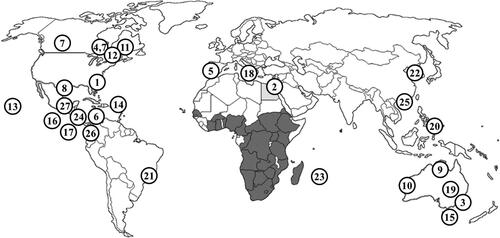Invasive species are of major concern globally because they affect human health and food security. To limit their spread and impact, locally and internationally concerted efforts are required. This holds true for invasive pests of pollinators, such as small hive beetles (Aethina tumida, Coleoptera: Nitidulidae), thus prompting the initiation of a COLOSS Task Force (TF) on this beetle.
The small hive beetle (SHB) naturally occurs in Africa south of the Sahara (Neumann & Elzen, Citation2004), where it is generally considered to be a minor problem for endemic honey bees. Since the SHB was introduced into the USA 25 years ago, it has established itself as an invasive species. Although it was not noticed as a threat until 1998, the consequences for apiculture have become much clearer since that time. The characteristic smell of collapsed colonies and the image of fermented honey flowing from honey houses, both due to SHB larval feeding behaviour, sticks to the memory of many (). Since then, SHBs have spread to all continents, except Antarctica, and many islands globally (). New introductions can trigger national eradication policies, which impact beekeepers economically and socially. Once established, the SHB requires beekeepers to adapt, for instance by applying controls to hives or changing basic hygienic measures in/around honey houses and apiaries. The SHB impacts honey bee colonies through mass reproduction, with thousands of larvae often causing the full structural collapse of the entire nest within two weeks. This can occur even in strong colonies. With the global spread, novel potential hosts, including species of other honey bees native to Asia, bumble bees, and stingless bees, have also been exposed to the SHB; but the consequences and possible impact of which are mostly unclear and require further attention. While SHBs might not be a priority for many beekeepers now, studies indicate that climate change could alter the impact of SHB distribution detrimentally (Cornelissen et al., Citation2019). Therefore, knowledge gaps abound and range from appropriate policy requirements, including monitoring and control, to many ecological conundrums. These gaps led to the development of the SHB TF.
Figure 1. Small hive beetle, Aethina tumida, mass reproduction: hundreds and sometimes even thousands of larvae feed on honey, pollen, brood and dead adult bees. The bees leave the hives and often the entire nest is completely destroyed (Picture taken by Michael Duncan).

Figure 2. Global distribution and confirmed introductions of small hive beetles to July 2021. Please refer to Neumann and Elzen (Citation2004), Neumann and Ellis (Citation2008), Neumann et al. (Citation2016), and Boncristiani et al. (Citation2021) for further references. Endemic distribution range in sub-Saharan Africa (= dark grey areas) and introductions (= white circles with numbering in chronological order) are shown: (1) 1996, Charleston, South Carolina, USA, (2) 2000, Itay-Al-Baroud, Egypt, (3) 2001, Richmond, NSW, Australia, (4) 2002, Manitoba, Canada, (5) 2004, Lisbon, Portugal, (6) 2005, Jamaica, (7) 2006, Alberta and Manitoba, Canada, (8) 2007, Coahuila, Mexico, (9) 2007, Kununurra, North Australia, (10) 2008, Perth Australia, (11) 2008, 2009, Quebec, Canada, (12) 2008, 2013 Ontario, Canada, (13) 2010, Pana’ewa, Big Island, Hawaii, (14) 2012, Cuba, (15) 2012, Naracoorte in Eastern South Australia; (16) 2013, El Salvador, (17) 2014, Nicaragua, (18) Sovereto, Calabria, Italy, (19) 2014, Renmark, Australia, (20) 2014, Lupon, Philippines, (21) 2015, Piracicaba, São Paulo State, Brazil (Toufailia, Citation2017), (22) 2016, Miryang-si, GN, Korea (Lee et al., Citation2017), (23) 2016, Mauritius Island (Muli et al., Citation2018), (24) 2016, Guanacoste, Costa-Rica (Ouessou Idrissou et al., Citation2019); (25) Guangdong & Hainan, China (Zhao et al., Citation2020; Liu et al., Citation2021); (26) Palmira, Columbia (Numa-Vergel et al., Citation2021), (27) Petén Dept., Guatemala (García-Ochaet, Citation2020).

We must go back to September 2014 for the origin of the SHB TF. What many in the bee research community feared became reality. First through rumours, but soon confirmed by the Italian National reference laboratory, SHBs were found in the community of Giao Tauro in Southern Italy (Mutinelli et al. Citation2014). Given that COLOSS was, at that time, more Euro-centric, this event can be singled out as the leading cause for the birth of the SHB TF. COLOSS members and others gathered in Bologna in February 2015, at which time it was decided to initiate the TF. The first meeting was held in Ljubljana, Slovenia of the same year, with Peter Neumann at the helm. Thereafter, Bram Cornelissen assumed chairman responsibilities and at the second meeting in Wageningen, established a TF agenda. The number of TF members grew exponentially and now includes about 75 members from around the world. Our TF community is a bit atypical in the sense that about half of the members are active in areas where the SHB is present, while the others reside in areas where its arrival is anticipated. This requires the TF to operate globally, while many COLOSS groups are more European orientated so far. In 2018, we were the first COLOSS TF to organise a meeting in the Americas at the University of Florida Honey Bee Research and Extension Laboratory in Gainesville Florida, USA.
The SHB TF aims to address knowledge gaps on several aspects of SHB research and has identified key areas on which to focus our joint research efforts. We aim to:
improve diagnostic methods for early detection.
improve and increase control options.
understand our nemesis’ biology and ecology better.
Our first accomplishment was developing/publishing a manuscript in which we outlined the needs and requirements to deal with SHBs globally from a policy perspective. This joint venture, led by Marc Schäfer, was published in Biological Invasions in 2018 (Schäfer et al., Citation2019). Here, we make a case for a better preparedness of both the relevant authorities as well as beekeepers, but also highlight the lack of quality tools for SHB control and detection. The latter is reflected in a second paper by Cornelissen and Neumann (Citation2018) in which we provide tips for professionals on how to screen colonies for SHBs. Although widely used to diagnose colonies for the presence of SHBs, we argue that visual screening is inaccurate and not very cost-effective. Therefore, the search for better alternatives continues. Now, we concentrate our efforts on four tasks through which we attempt to optimize SHB detection using PCR. Here, the first step is to identify which detection protocol works best. This will be determined using a ring test. Second, we are developing a manuscript that reflects the state-of-the-art on SHB control. We aim to include a range of methods and regions where they are applied. At the same time, we are looking for new ways to control SHBs. Bio-technical solutions are of particular interest. For instance, one can optimize traps and include soil treatments, such as inundation or heat treatment. Lastly, we lack information on the actual impact of SHBs to beekeeping operations. Anecdotal information abounds; yet only with a dedicated strategy to obtain information directly from beekeepers can we gain insight into the true global impact of SHBs. Correspondingly, an international survey will be conducted to assess the global impact of SHBs. This will give us insight in the financial consequences of SHB, but also allow us to pinpoint future research needs.
Future plans include behavioural studies on SHBs, and, in particular, on mass reproduction. This behaviour has been observed and described in detail; yet the mechanisms triggering it are poorly understood. Also, we foresee an emerging knowledge gap growing as SHBs spread further globally. This mainly entails its imminent impact on other pollinator species. In particular, honey bee species in Asia may be vulnerable to SHBs (Liu et al., Citation2021). Moreover, species of stingless bees and bumble bees are potential hosts for SHBs (Neumann et al., Citation2016), but information and research effort directed at these threats are scarce. The scientific questions obviously remain, and demand is high for a dedicated taskforce. With the ever-ongoing spread of SHBs globally, the SHB TF will remain relevant for the decades to come.
Bram (A.C.M.) Cornelissen*
Wageningen Plant Research, Wageningen University & Research, Wageningen, the Netherlands*Email: [email protected] (A.C.M.) Cornelissen http://orcid.org/0000-0001-6610-0811
Peter Neumann
Institute of Bee Health, Vetsuisse Faculty, University of Bern, Bern, SwitzerlandSwiss Bee Research Centre, Agroscope, Bern, SwitzerlandPeter Neumann http://orcid.org/0000-0001-5163-5215
Acknowledgements
We wish to thank all who remain curious to learn about small hive beetles through their research. We thank the members of the COLOSS Small Hive Beetle Task Force for contributing to the goals we set out to achieve. Over the years, COLOSS has become the beating heart of the bee research community. We thank those who make it real.
Disclosure Statement
No potential conflict of interest wasreported by the authors.
References
- Boncristiani, H., Ellis, J. D., Bustamante, T., Graham, J., Jack, C., Kimmel, C. B., Mortensen, A., & Schmehl, D. R. (2021). World honey bee health: the global distribution of western honey bee (Apis mellifera L.) pests and pathogens. Bee World, 98(1), 2– 6. https://doi.org/https://doi.org/10.1080/0005772X.2020.1800330
- Cornelissen, B., & Neumann, P. (2018). How to Catch a Small Beetle: Top Tips for Visually Screening Honey Bee Colonies for Small Hive Beetles. Bee World, 95(3), 99–102. https://doi.org/10.1080/0005772X.2018.1465374
- Cornelissen, B., Neumann, P., & Schweiger, O. (2019). Global warming promotes biological invasion of a honey bee pest. Global Change Biology, 25(11), 3642–3655. https://doi.org/https://doi.org/10.1111/gcb.14791
- García-Ochaet, J. F. (2020). Primer registro del pequeño escarabajo de la colmena Aethina tumida Murray (Coleoptera: Nitidulidae) en colmenas de abejas africanizadas en Guatemala. Insecta Mundi, 0826, 1–4.
- Lee, S., Hong, K.-J., Cho, Y. S., Choi, Y. S., Yoo, M.-S., & Lee, S. (2017). Review of the subgenus Aethina Erichson s. str. (Coleoptera: Nitidulidae: Nitidulinae) in Korea, reporting recent invasion of small hive beetle, Aethina tumida. Journal of Asia-Pacific Entomology, 20(2), 553–558. https://doi.org/https://doi.org/10.1016/j.aspen.2017.03.006
- Liu, Y., Han, W., Gao, J., Su, S., Beaurepaire, A., Yañez, O., & Neumann, P. (2021). Out of Africa: Novel source of small hive beetles infesting Eastern and Western honeybee colonies in China. Journal of Apicultural Research., 60(1), 108–110. https://doi.org/https://doi.org/10.1080/00218839.2020.1816686
- Muli, E., Kilonzo, J., & Sookar, P. (2018). Small hive beetle infestations in Apis mellifera unicolor colonies in Mauritius Island, Mauritius. Bee World, 95(2), 44–45. https://doi.org/https://doi.org/10.1080/0005772X.2018.1434751
- Mutinelli, F., Montarsi, F., Federico, G., Granato, A., Ponti, A. M., Grandinetti, G., Ferrè, N. Franco, S., Duquesne, V., Rivière, M. P., Thiéry, R., Henrikx, P., Ribière-chabert, M., & Chauzat, M. P. (2014). Detection of Aethina tumida Murray (Coleoptera: Nitidulidae.) in Italy: outbreaks and early reaction measures. Journal of Apicultural Research, 53(5), 569–575. https://doi.org/https://doi.org/10.3896/IBRA.1.53.5.13
- Neumann, P., & Ellis, J. D. (2008). The small hive beetle (Aethina tumida Murray, Coleoptera: Nitidulidae): Distribution, biology and control of an invasive species. Journal of Apicultural Research., 47, 180–183.
- Neumann, P., & Elzen, P. J. (2004). The biology of the small hive beetle (Aethina tumida, Coleoptera: Nitidulidae): Gaps in our knowledge of an invasive species. Apidologie, 35(3), 229–247. https://doi.org/https://doi.org/10.1051/apido:2004010
- Neumann, P., Pettis, J. S., & Schäfer, M. O. (2016). Quo vadis Aethina tumida? Biology and control of small hive beetles. Apidologie, 47(3), 427–466. https://doi.org/https://doi.org/10.1007/s13592-016-0426-x
- Numa-Vergel, S. J., Sandoval-Cáceres, Y. P., & Vergara-Navarro, E. V. (2021). First record of Aethina tumida Murray (Coleoptera: Nitidulidae) in Colombia. Journal of Agricultural and Urban Entomology, 37(1), 33–37. https://doi.org/https://doi.org/10.3954/JAUE21-09
- Ouessou Idrissou, F., Huang, Q., Yañez, O., & Neumann, P. (2019). International beeswax trade facilitates small hive beetle invasions. Scientific Reports, 9(1), 10665https://www.nature.com/articles/s41598-019-47107-6. https://doi.org/https://doi.org/10.1038/s41598-019-47107-6
- Schäfer, M. O., Cardaio, I., Cilia, G., Cornelissen, B., Crailsheim, K., Formato, G., Kayode, A. L., Le Conte, Y., Mutinelli, F., Nanetti, A., Rivera-Gomis, J., Teepe, A., & Neumann, P. (2019). How to slow the global spread of small hive beetles, Aethina tumida. Biological Invasions, 21(5), 1451–1459. https://doi.org/https://doi.org/10.1007/s10530-019-01917-x
- Toufailia, H. A. (2017). First record of small hive beetle, Aethina tumida Murray, in South America. Journal of Apicultural Research., 56, 76–80.
- Zhao, H., Yang, S., Liu, J., Huang, W., Ji, C., Ren, Q., Xia, X., & Hou, C. (2020). First detection of small hive beetle Aethina tumida Murray (Coleoptera: Nitidulidae) infesting eastern honeybee, Apis cerana Fabricius (Hymenoptera: Apidae), in China. Sociobiology, 67(1), 126–128. https://doi.org/https://doi.org/10.13102/sociobiology.v67i1.4381
